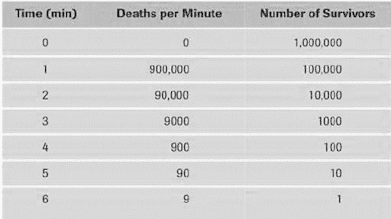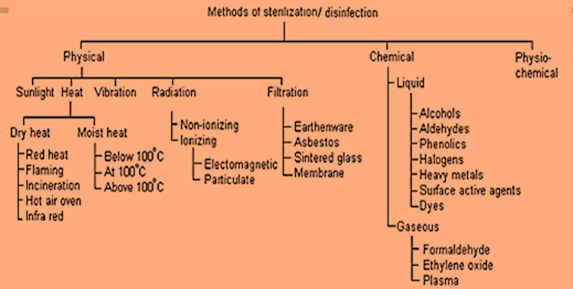Concept of sterilization and sterilization methods
Learning objectives
At the end of this lecture, the student will be able to:
• Explain different terminologies related to sterilization
• Explain ‘D value’ and ‘Z value’
• List the different methods of sterilization
History of Sterilization
• In ancient times, demons and evil spirits were thought to
be the cause of pestilence and infection.
• Methods involving witchcraft and magic were used to drive
them away.
• 3,000 BC – The use of antiseptics such as pitch or tar, resins and aromatics was widely employed by the Egyptians in embalming bodies- known as Mummies.
• Moses (circa 1450 BC) was the first to prescribe a system of purification by fire
• Greek Infantry men known as hoplite sometimes fought
naked, especially against fast-moving cavalry they believed that pieces of clothing carried into a wound by a penetrating sword or spear point were more likely to cause infection.
• Galen (130-200 AD), a Greek who practiced medicine in Rome and was the most distinguished physician after Hippocrates, boiled instruments used in caring for wounded Roman gladiators.
• In Hippocrates of Cos (460-377 BC), was the first to separate medicine from philosophy and disproved the idea that disease was punishment for sin. He also advocated
irrigation of wounds with wine or boiled water, as an aseptic method
• Denis Papin, a French physicist, invents the “Digester” (pressure cooker) in 1680
• In 1758 – the earliest use of surgical glove. Dr. Johann Julius Walbaum formed a glove from the intestines of a sheep and used it to deliver babies.
• Ignaz Semmelweis, an Hungarian obstetrician, advocated in 1847 the value of handwashing and fingernail scrubbing.
• In 1862, French chemist and microbiologist Louis Pasteur publishes his findings on how germs cause disease, which he later uses to develop the pasteurization process.
• Joseph Lister, an English physician, reduced the mortality rate of his patients in 1867 by using a carbolic solution spray as he operated, he then used it in the wound, on the articles in contact with the wound and on the hands of the operating team.
• In 1885, Ernst von Bergmann, a German physician, first used the steam sterilizer for the sterilization of surgical dressings.
• Gustav Neuber introduced mercury chloride in 1886 to clean his apron
• He advocated scrubbing the furniture with disinfectant and sterilizing everything in contact with the wounds.
• Around 1889, Dr. William Stuart Halstead, to remedy a nurse’s complaints of dermatitis caused by the strong.chemical disinfectants used to perform hand scrubs, asked the Goodyear Rubber Company if they could create a thin rubber glove to protect their hands.
The Terminology of Microbial Control
• Sterilization refers to any process that involves the removal or destruction of all forms of microbial life
• A sterilizing agent is called a sterilant
• Sterile means “Free from viable micro-organisms”
• Disinfection describes a process that eliminates many or
all pathogenic microorganisms, except bacterial spores, on inanimate objects
• Antisepsis is the prevention of infection or sepsis and is
accomplished with antiseptics.
• Degerming is the mechanical removal, rather than the
killing, of most of the microbes in a limited area.
• Sanitization is intended to lower microbial counts to safe
public health levels and minimize the chances of disease transmission from one user to another
Terminology Relating to the Control of Microbial Growth
The Rate of Microbial Death
When bacterial populations are heated or treated with
antimicrobial chemicals, they usually die at a constant rate.
Microbial Exponential Death Rate: An Example
The rate and pattern of microbial death
If the death curve is plotted logarithmically, the death
rate is constant, as shown by the straight line
• Population death, like population growth, is generally
exponential or logarithmic
• The population will be reduced by the same fraction at
constant intervals
• When the population has been greatly reduced, the rate of
killing may slow due to the survival of a more resistant strain of the microorganism
Actions of Microbial Control Agents
Alteration of Membrane Permeability
• Damage to the lipids or proteins of the plasma membrane by antimicrobial agents
• Causes cellular contents to leak into the surrounding
medium and interferes with the growth of the cell.
Damage to Proteins and Nucleic Acids
• Damage to these nucleic acids by heat, radiation, or
chemicals is frequently lethal to the cell
• The cell can no longer replicate, nor can it carry out
normal metabolic function such as the synthesis of enzymes
Expressions of resistance
D-value
• Resistance of an organism to a sterilizing agent can be
described by means of the D-value
• Defined as ‘the time taken at a fixed temperature or the
radiation dose required to achieve a 90% reduction in viable cells’
Z-value
• In order to assess the influence of temperature changes on
thermal resistance a relationship between temperature and log D-value can be developed, leading to the expression of a z-value
• Represents the increase in temperature needed to reduce
the D-value of an organism by 90%
D-value and Z-value
Sterilization methods
• Physical methods
– Heat methods
¨ Dry heat sterilization
¨ Moist heat sterilization
– Radiation sterilization
• Chemical methods
• Mechanical methods
– Filtration sterilization
Summary
• Sterilization is the removal or destruction of all forms
of microbial life
• Disinfection refers to the destruction of vegetative (non-endospore-forming) pathogens
• Microbial death follows an exponential pattern
• Microbial control agents act by alteration of membrane permeability or damage to proteins and nucleic Acids
For PDF Notes Click on Download Button





